Navigating the World of Pet Cremation Technology
Incinerator dog cremation refers to the process of using specialized combustion equipment to respectfully reduce a deceased pet's remains to ashes that can be returned to the owner. For funeral directors or veterinary professionals seeking quick information:
| Key Aspects of Incinerator Dog Cremation | Details |
|---|---|
| Equipment Types | Single-chamber, multi-chamber, front-loading, automated |
| Temperature Range | 800°C-1200°C (1472°F-2192°F) |
| Average Cycle Time | 1-2 hours for individual dog cremation |
| Cost to Purchase | $21,700-$35,000+ depending on capacity |
| Return on Investment | ~$11,000 net profit first year (processing 1+ cremation/week) |
| Capacity Options | Small units (7 pets/day) to large (60 pets/day) |
The growing preference for cremation over burial has transformed pet aftercare services in recent years. With an estimated 34 million pets in the UK alone and similar numbers proportionally in the US, the demand for dignified pet cremation services continues to rise.
Why consider on-site cremation equipment?
- Control over the process - guarantee individual cremations
- Additional revenue stream - average $180 per cremation
- Reduced third-party costs - eliminate outsourcing fees
- Customer trust - offer witnessing options for pet owners
For veterinary clinics performing just over one cremation per week, a small pet crematory unit can generate nearly $50,000 in annual sales with a net profit exceeding $20,000.
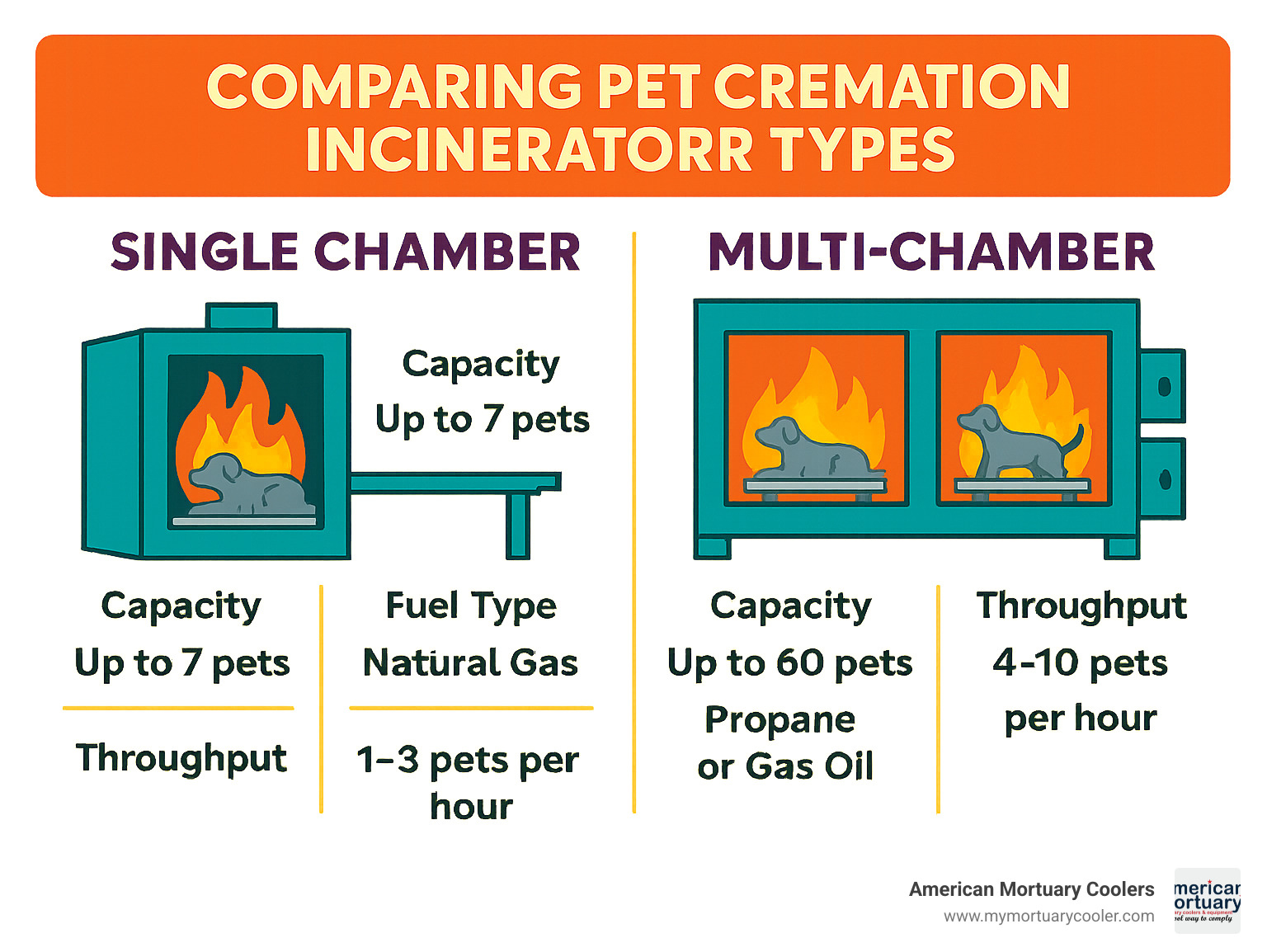
Incinerator dog cremation terms explained:
Understanding Incinerator Dog Cremation
When a beloved pet passes away, incinerator dog cremation offers a dignified, environmentally conscious alternative to traditional burial. This process involves carefully controlled thermal decomposition at high temperatures. It's worth noting how quickly cremation has grown in popularity - human cremation rates jumped from just 15% in 1985 to over 50% by 2020, with pet cremation rates climbing even faster due to changing regulations and evolving family preferences.
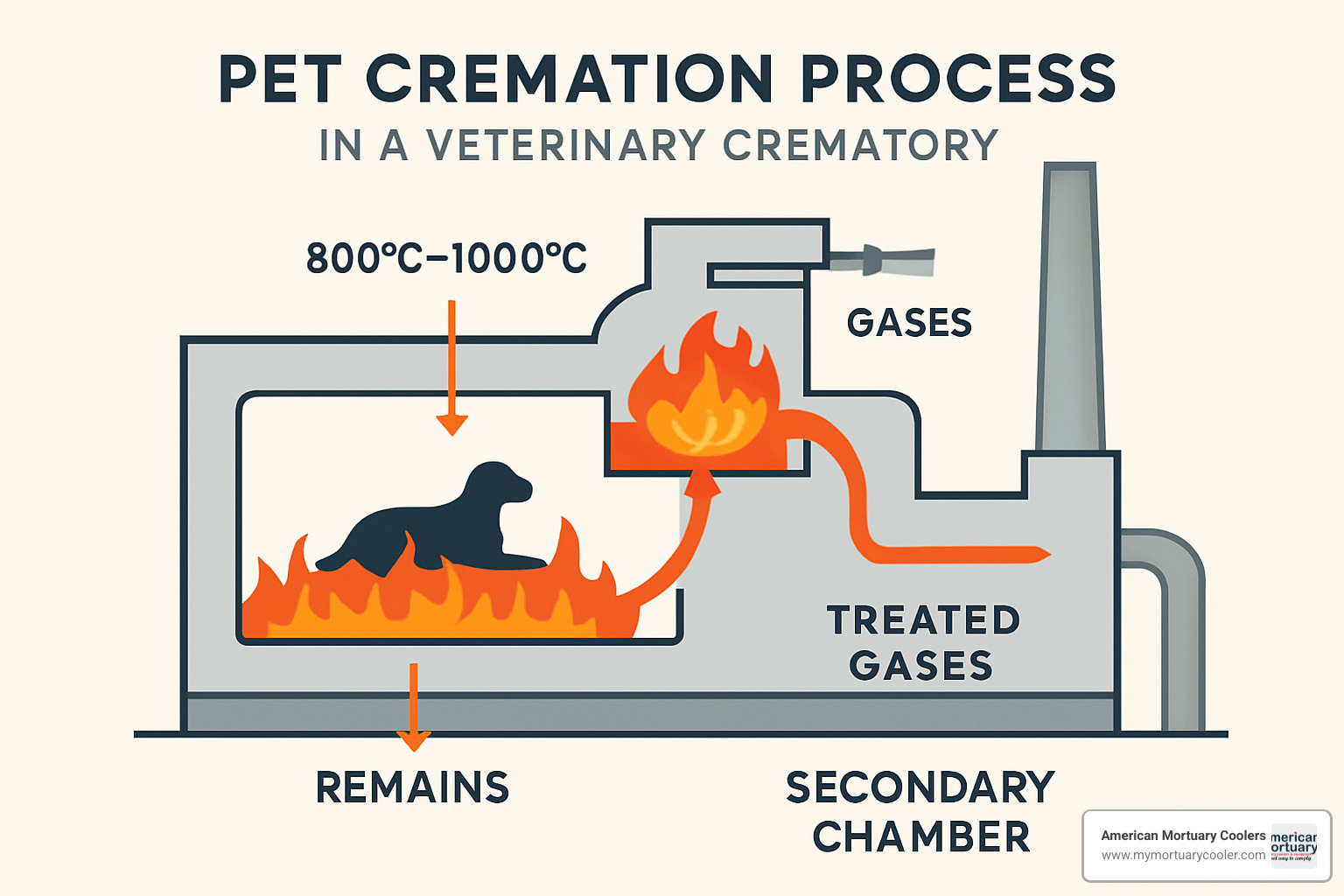
The science behind pet cremation is straightforward. Modern equipment operates using two essential components:
The Primary Chamber is where your pet's remains are placed. Initial combustion happens here at temperatures between 800°C and 1000°C (1472°F-1832°F) - hot enough to ensure complete reduction of organic material.
Above this sits the Secondary Chamber, where gases and particles undergo further combustion at temperatures up to 1200°C (2192°F). This crucial second stage ensures complete combustion and minimizes emissions, making the process environmentally responsible.
These high temperatures reduce organic matter to bone fragments, which are then processed into the fine ash that families receive. Throughout this journey, strict environmental regulations govern the process - including those established by DEFRA in the UK and the EPA in the United States. These standards ensure pet cremation remains a clean, respectful option for pet cremation.
What "incinerator dog cremation" really means
The terminology around incinerator dog cremation often creates confusion. Let me clarify:
The terms cremator and incinerator technically refer to the same equipment. As one industry expert puts it, "The main difference between an incinerator and a cremator is just the spelling!" That said, the terminology can matter for permitting purposes in some areas - "cremator" is typically preferred for pet remains while "incinerator" is often associated with waste disposal.
Incinerator dog cremation specifically describes the compassionate process of cremating canine remains in purpose-built equipment designed with respect and dignity in mind. While the physical principles mirror human cremation, the equipment design, regulatory requirements, and operational protocols are custom specifically for our animal companions.
Types of units used for incinerator dog cremation
When it comes to equipment for incinerator dog cremation, veterinary clinics and pet memorial businesses have several options:
Single-chamber batch units serve as entry-level models perfect for small veterinary practices or new pet cremation businesses. Systems like the PET-200 can handle up to 7 pet cremations daily.
For established pet memorial centers with higher volume needs, multi-chamber continuous process units like the A50-IC series can accommodate 15-60 pets daily, dramatically increasing efficiency.
Modern hot-hearth technology represents a significant advancement, offering 360° heat penetration from both above and below. This innovation ensures more efficient combustion and complete reduction of remains.
Front-loading systems prioritize operator comfort with waist-height doors that reduce physical strain and improve workflow efficiency - an important consideration for facilities performing multiple cremations daily.
Though less common, mobile cremation units provide portability for services that travel to different locations, offering flexibility for unique business models.
Choosing the Right Pet Cremation Incinerator: Capacity, Technology & Costs
Selecting the perfect incinerator dog cremation equipment feels a bit like finding the right car - you need something that fits your specific needs while staying within budget. Let's walk through what really matters when making this important investment.
Think about burn rate as your equipment's processing speed. Smaller units handle around 10-50 kg per hour - perfect for a veterinary clinic - while larger industrial machines can process up to 500 kg hourly for high-volume operations.
Chamber volume determines which pets you can accommodate. Standard units with chambers around 0.63 m³ work beautifully for most dogs and cats, but if you're planning to offer equine services, you'll need significantly more space.
When it comes to fuel options, you've got three main choices:
- Natural gas tends to burn cleanest and often costs less where available
- Liquid propane (LP) offers a good middle-ground with wide availability
- Diesel works in remote locations but produces higher emissions
Modern units now feature smart PLC systems that handle the technical work for you. These digital brains monitor temperatures, adjust airflow, and control burners automatically - making operation much simpler.
Hot Hearth Technology represents one of the biggest advancements in recent years. By placing heating elements in both the ceiling and floor, these systems provide 360° heat penetration for more efficient cremations.
Some manufacturers offer modular systems that grow with your business. Start with a base unit, then add chambers as demand increases - a smart way to protect your initial investment.
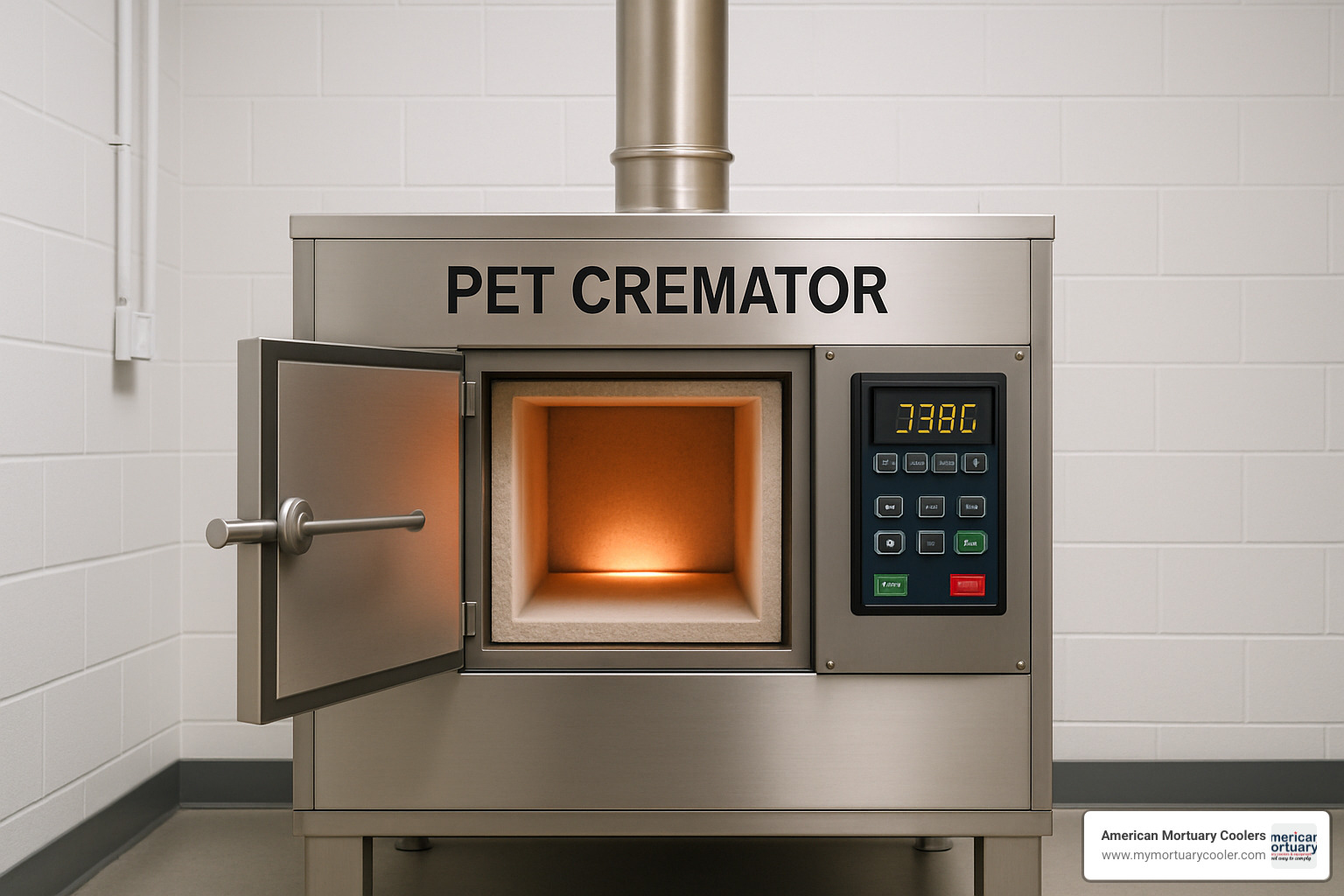
Comparing entry-level vs. high-throughput models
| Feature | Entry-Level (PET-200) | Mid-Range (A-Series) | High-Throughput (P-Series) |
|---|---|---|---|
| Daily Capacity | 5-7 pets | 15-30 pets | 30-60 pets |
| Chamber Size | 0.63 m³ | 1.2-1.8 m³ | 2.0-3.0 m³ |
| Approximate Cost | $21,700 | $28,000-$32,000 | $35,000+ |
| Cycle Time | 1.5-2 hours | 1-1.5 hours | 45-60 minutes |
| Fuel Consumption | Moderate | Medium-High | High |
| Ideal For | Small vet clinics, startups | Dedicated pet crematoriums | High-volume operations |
| ROI Timeline | 5 years | 3-4 years | 2-3 years |
Hidden costs & financing tips
The sticker price is just the beginning when investing in incinerator dog cremation equipment. Let's talk about what else you should budget for:
Installation typically runs between $600-$2,500 depending on your facility. This covers preparing a concrete pad, connecting utilities, and initial setup.
Permitting fees vary wildly by location. While some rural areas might charge just $500, urban centers with stricter environmental regulations could demand several thousand dollars.
Fuel consumption becomes your ongoing operational cost. A small crematory processing one pet daily might spend around $24 per session, adding up to approximately $6,336 annually.
Maintenance contracts protect your investment. Budget $1,500-$3,000 yearly for preventative care and repairs.
For more detailed information about price factors, check out this comprehensive guide on the real price of pet incinerators.
Regulatory, Environmental & Operational Essentials
Running an incinerator dog cremation facility involves more than just turning on the equipment. There's a whole world of regulations and best practices you'll need to steer to keep your operation legal, safe, and environmentally responsible.
Air quality permits are usually your first hurdle. Most cities and counties require these before you can even install your equipment. These permits typically involve an initial application process, regular emissions testing, and renewal fees.
In Europe, pet cremation falls under the Animal By-Products Regulation (EC) No 1069/2009, while in the US, regulations vary by state and locality.
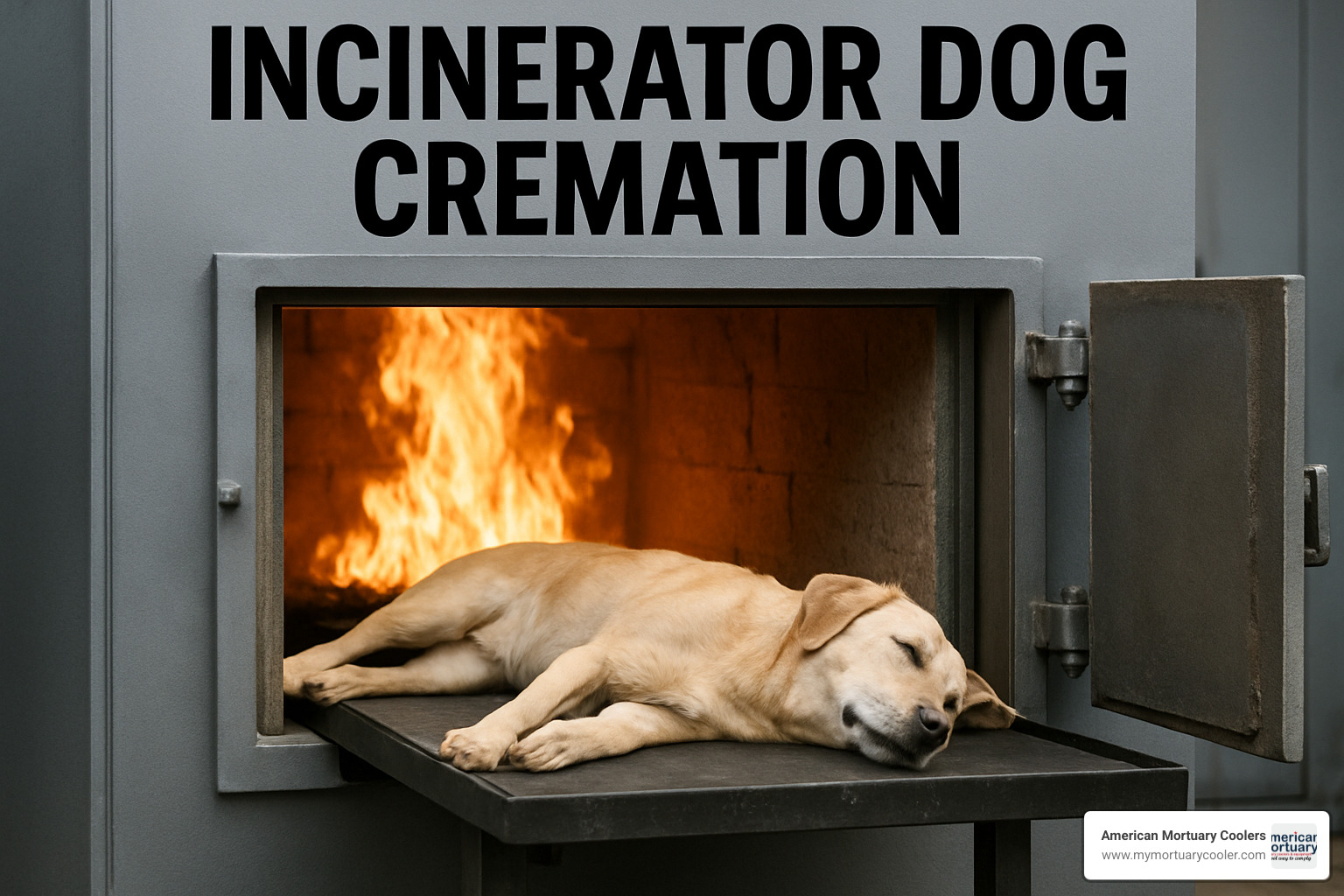
Stack testing involves periodic testing of what's coming out of your crematory stack. These tests measure particulate matter, carbon monoxide, and other emissions to ensure you're meeting air quality standards.
Modern incinerator dog cremation units come equipped with emission control technologies. After-burners (secondary combustion chambers) ensure complete combustion of gases, while optional wet scrubbers use water to remove particulates.
Your team will need proper training too. Some jurisdictions require formal operator certification, but even where it's not mandated, comprehensive training on safety protocols, emergency procedures, and proper loading techniques is essential.
Don't skimp on personal protective equipment! Heat-resistant gloves and face shields protect operators during loading and unloading, respiratory protection keeps lungs safe during ash handling, and appropriate protective clothing completes the safety ensemble.
Regular maintenance keeps your equipment running smoothly and safely. Schedule routine inspections of the refractory material, have burners maintained and calibrated, and keep your control systems updated.
Sustainable incinerator dog cremation practices
Pet owners today care deeply about environmental impact, so implementing sustainable practices in your incinerator dog cremation operation isn't just good for the planet - it's good business.
Modern pet cremation units incorporate sophisticated emission control systems that significantly reduce environmental impact. High-efficiency secondary combustion chambers ensure complete combustion of gases, while temperature monitoring systems maintain optimal operating conditions.
Some forward-thinking pet crematories have begun participating in carbon offset programs to balance their emissions footprint. These might involve investing in renewable energy projects, supporting reforestation initiatives, or purchasing carbon credits.
The most advanced facilities are implementing energy recovery systems that capture waste heat from the cremation process. This reclaimed energy can heat your facility, warm water, or even generate power in larger operations.
For more detailed insights into current best practices and regulatory requirements, check out Pet Cremation Insights for up-to-date information that can help keep your operation compliant and efficient.
Profitability & Business Models for Clinics and Pet Crematories
When it comes to incinerator dog cremation, the financial opportunity is surprisingly robust for both veterinary practices adding this service and dedicated pet cremation businesses.
Pricing Structures in this industry follow a tiered approach. Individual cremations typically range from $100-150 for small pets, while medium-sized dogs command $200-250, and large breeds $300-400. Many facilities also offer communal cremation at a flat $50-100 fee when families don't wish to keep the ashes.
Beyond the basic cremation service, there's a world of thoughtful memorial products that provide both comfort to grieving pet owners and additional revenue streams. Premium urns ($50-300), memorial jewelry containing a small portion of ashes ($75-250), and keepsakes like paw prints or fur clippings ($25-50) all help families honor their beloved companions.
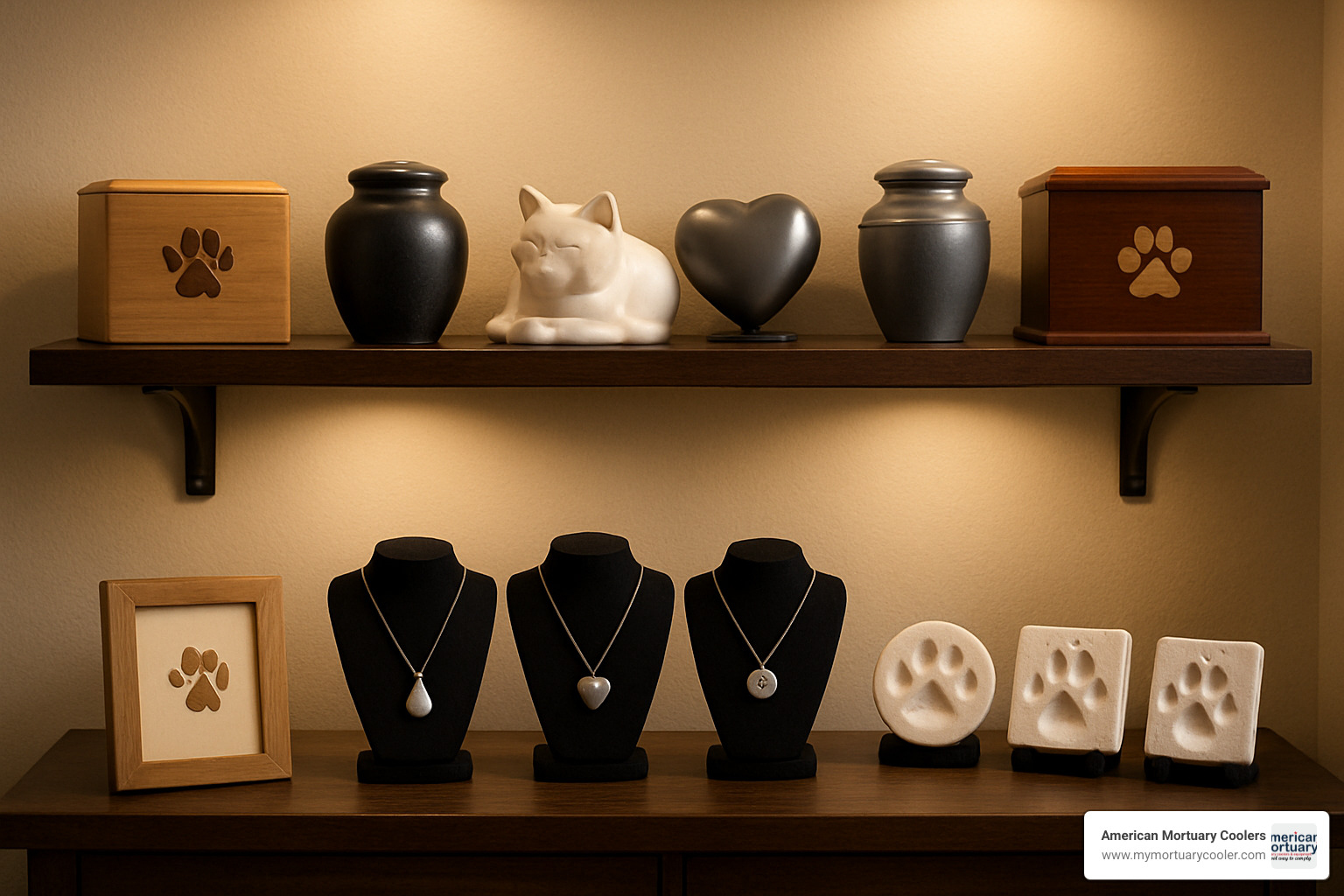
The smartest operators focus on operational efficiency to maximize profitability. Multi-animal separation trays significantly reduce the cost per cremation while ensuring each pet's ashes remain distinct. Scheduling multiple cremations per day optimizes fuel usage, and proper maintenance extends equipment life well beyond 15 years in most cases.
Sample revenue projections
Let's look at what these numbers mean in practice across different business models:
For a Small Veterinary Clinic starting with a modest A-series cremator ($21,700), performing just 7 cremations weekly (364 annually) at an average of $180 each generates $65,520 in annual revenue. After accounting for operating costs, the net annual profit exceeds $32,000 once the equipment is paid off.
A Dedicated Pet Crematory using a multi-chamber P-series unit ($35,000+) handling 30 cremations daily can generate truly impressive numbers: 7,800 annual cremations at $200 average revenue creates $1,560,000 yearly revenue.
For those serving rural communities, an Equine Cremation Add-On can be lucrative. A specialized large-animal cremator handling just 2-3 horses weekly at $1,500 per cremation adds $180,000 in annual revenue.
Marketing and client experience improvers
The most successful pet cremation businesses differentiate themselves through exceptional client experiences rather than competing solely on price.
A strong digital presence is no longer optional. Online booking systems for cremation appointments, virtual memorial walls where clients can share memories of their pets, and educational content about the cremation process all build trust.
Facility improvements make a tremendous difference in how families experience your service. Private viewing rooms for final goodbyes create a sacred space for closure.

Thoughtful client communications build trust in your process. Transparent chain-of-custody documentation, photo confirmation of individual cremation (with permission), and compassionate aftercare follow-up calls or cards show families their pet was treated with dignity.
Step-by-Step Process: From Intake to Returning Ashes
The journey of incinerator dog cremation is a carefully choreographed process that balances technical precision with compassionate care. Let's walk through what happens from the moment you say goodbye to your beloved companion until their ashes return home.
When a pet arrives at our facility, we begin with thorough documentation. We verify your pet's identity, collect your contact information, and assign a unique tracking number that stays with your pet throughout the entire process. This identification tag ensures your pet's remains are never confused with others.
The preparation phase is handled with dignity and respect. For individual cremations, we carefully place your pet in an appropriate container, positioning them either in a dedicated chamber or on a separation tray designed to keep remains distinct.
The actual cremation begins once the chamber reaches optimal temperature—typically between 800-1000°C. Your pet is carefully placed in the primary chamber, and both primary and secondary burners activate to ensure complete and efficient cremation. Depending on your dog's size, the cremation itself usually takes between 1-2 hours.
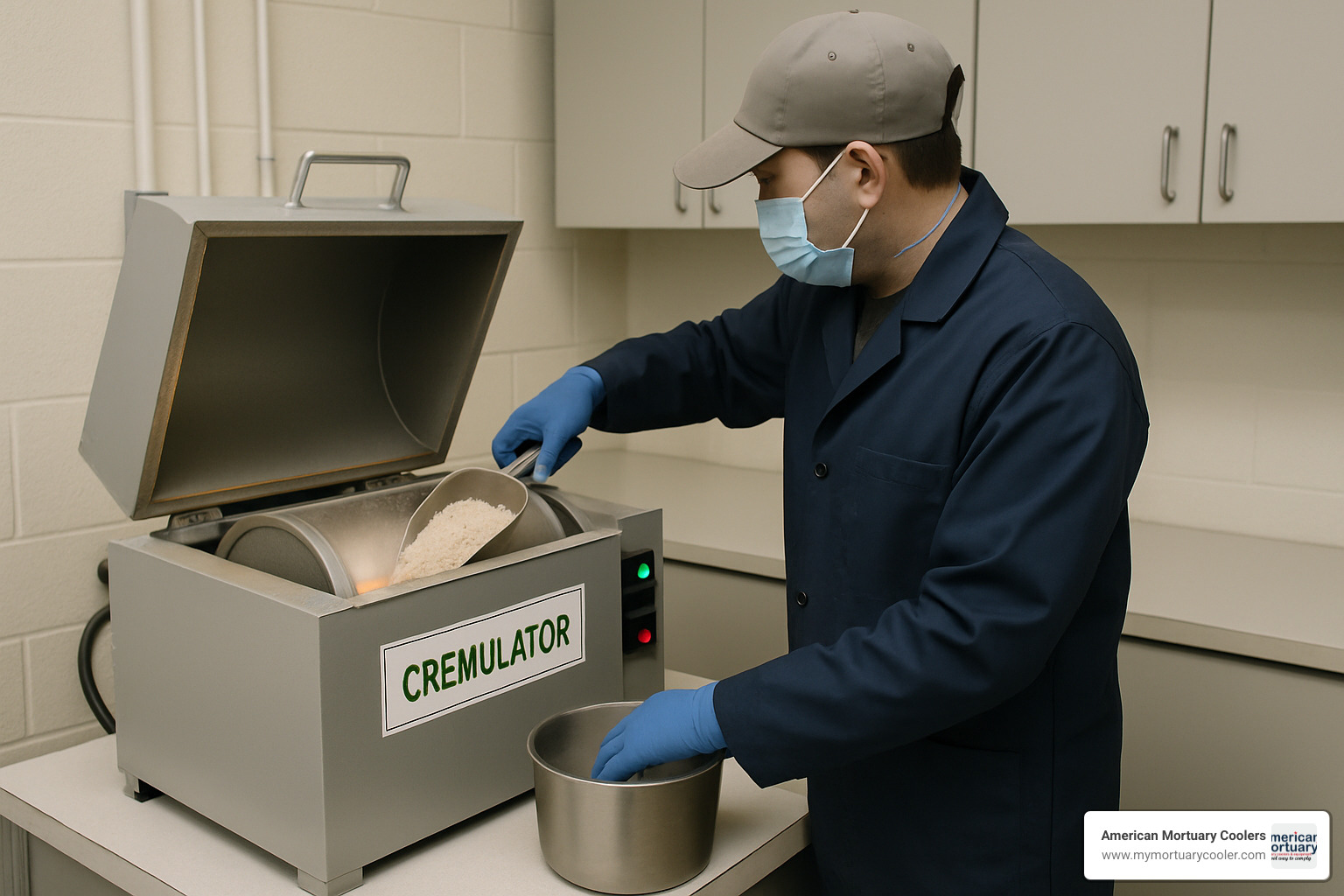
After cremation comes the cool-down period. We allow the cremains to cool naturally, which typically takes 1-3 hours. Some facilities use specialized cooling chambers to gently accelerate this process.
Once cooled, we begin the careful processing of your pet's ashes. We collect all cremated remains from the chamber and remove any non-combustible materials such as identification tags or surgical implants. The remains are then processed in a cremulator—a specialized machine that gently reduces bone fragments to fine ash.
The final step brings closure to the journey. We transfer your pet's processed ashes to your selected urn or container, carefully attach identification information, and prepare a certificate of cremation.
Individual vs. communal incinerator dog cremation
When considering incinerator dog cremation, pet parents typically face a choice between individual and communal services, each offering different benefits.
With individual cremation, your pet is cremated either alone in the chamber or in a carefully partitioned area. This means all recovered ashes belong solely to your pet. While this option costs more due to dedicated chamber time and individual processing, it provides the comfort of knowing you're receiving only your pet's remains.
Communal cremation takes a different approach. Multiple pets are cremated together, and ashes are not returned to owners. Instead, remains are typically scattered in designated memorial gardens or respectfully disposed of according to facility practices. This option comes at a lower cost—usually a flat fee between $50-100.
Some facilities offer a middle ground called "partitioned cremation," where pets are cremated in the same chamber but separated by partitions. This allows for the return of predominantly your pet's ashes, at a price point between individual and communal options.
The choice between these options often comes down to personal preference and emotional needs. Individual cremation provides guaranteed return of your pet's ashes and options for witnessing, but at a higher cost ($150-400 depending on pet size).
Frequently Asked Questions about Incinerator Dog Cremation
How long does a dog cremation take in an incinerator?
When pet owners ask about timing, I always explain that incinerator dog cremation is a process that can't be rushed. The time needed depends on several important factors.
For small dogs under 25 pounds, the actual cremation typically takes 1-1.5 hours. Medium-sized dogs between 25-50 pounds usually need about 1.5-2 hours, while larger breeds over 50 pounds might require 2-3 hours for complete cremation.
The equipment makes a difference too. If you're using one of the newer models with Hot Hearth technology, you might shave 15-30% off these times.
Temperature settings play a role as well. While higher temperatures (within safe limits) can speed things up, we always need to balance this against proper emission control.
After the active cremation phase completes, there's still the cool-down period. This typically adds another 1-3 hours before the remains can be safely handled and processed.
Are the ashes really my pet's alone?
This question touches on what matters most to pet parents. With incinerator dog cremation, the answer depends entirely on the type of service you choose.
With true individual cremation, only one pet is placed in the chamber at a time. This ensures that 100% of the ashes you receive belong only to your beloved companion. Many facilities welcome families to witness the loading process for additional peace of mind.
Some facilities offer what's called partitioned cremation, where they use separation trays or dividers to cremate multiple pets simultaneously while keeping remains largely separate. While this method maintains mostly individual ashes, some minimal commingling may occur.
In communal cremation, multiple pets are cremated together, and no ashes are returned to owners. This is typically the most affordable option.
The best cremation providers implement strict tracking protocols throughout the entire process. These include unique identification tags that stay with your pet, photographic documentation at key stages, and thorough cleaning of chambers between individual cremations.
What permits do I need to install an on-site dog cremation incinerator?
If you're considering adding incinerator dog cremation services to your facility, navigating the permitting process is an important first step.
Most importantly, you'll need an Air Quality Permit from your local environmental agency or EPA. This typically involves providing emissions calculations for your specific equipment, documenting your pollution control measures, and demonstrating compliance with local air quality standards.
Building and construction permits are also necessary. These ensure proper installation according to building codes, adequate ventilation and safety features, appropriate electrical and fuel connections, and compliance with local zoning regulations.
You'll likely need a specific business license for pet cremation services. This often includes proving your staff has proper training, passing facility inspections, and showing compliance with regulations about handling animal remains.
The entire permitting process typically takes 2-6 months, depending on your location. Work with equipment manufacturers who have experience in your region to help streamline the process.
Conclusion
The field of incinerator dog cremation continues to evolve with technological advancements that make the entire process more efficient, environmentally friendly, and meaningful for everyone involved. As we look to the future, several exciting developments are on the horizon.
Modern cremation systems are increasingly incorporating smart technology that allows operators to monitor and control the process remotely. Imagine being able to check on a cremation cycle from your smartphone, receiving real-time alerts about temperature or completion – this technology is already becoming a reality for many facilities.
Heat recovery systems represent another significant advancement. Rather than letting all that thermal energy go to waste, newer units capture it to heat facilities or provide hot water, creating a more sustainable operation.
Environmental considerations continue to drive innovation in this field. Advanced filtration systems and more efficient combustion processes are making incinerator dog cremation increasingly eco-friendly, allowing businesses to reduce their carbon footprint while providing this essential service.
For veterinary clinics, funeral homes, or entrepreneurs considering this business opportunity, quality equipment is an investment that pays for itself. With thoughtful planning and the right equipment, even small operations can become profitable within the first year.
At American Mortuary Coolers, we understand the delicate nature of pet aftercare services. While our specialty lies in custom mortuary coolers, we've built relationships with trusted partners nationwide who provide excellent incinerator dog cremation equipment. From our locations spanning New York to Los Angeles and throughout the Midwest, Southeast, and Southwest, we're positioned to offer guidance regardless of where you're located.
If you're considering adding pet cremation services, here's a simple path forward:
- Evaluate your facility's space and available utilities
- Research local regulations and permitting requirements
- Calculate your projected volume based on your specific market
- Choose equipment that matches your anticipated needs
- Develop a comprehensive business plan including financing and marketing
For more information about getting started with cremation equipment, visit our cremation equipment 101 guide for additional insights and resources.